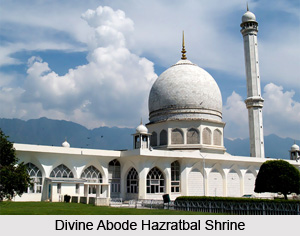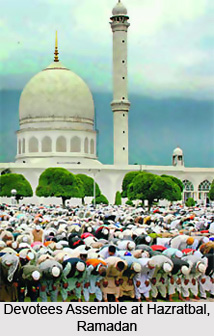 Hazratbal Shrine is revered as one of the most sacred shrines of the northern Indian state of Kashmir, being situated at the capital of this state, Srinagar. It is present on the left banks of the breathtaking lake of Kashmir, Dal Lake. This marble-made shrine is believed to provide refuge to the holy `Moi-e-Muqaddas` which is a relic, implying a hair of the Islamic Prophet Muhammad. The name `Hazratbal` is a derivation of the Arabic term `Hazrat`, meaning monumental or sacred and also a Kashmiri word `bal` meaning place. However, the term `bal` is also believed to be obtained from a Sanskrit term named `Vala`. The current marble form of the shrine was started by Muslim Auqaf Trust which was spearheaded by Sheikh Mohammad Abdullah during the year 1968, and was finally finished in the earlier part of the year 1979.
Hazratbal Shrine is revered as one of the most sacred shrines of the northern Indian state of Kashmir, being situated at the capital of this state, Srinagar. It is present on the left banks of the breathtaking lake of Kashmir, Dal Lake. This marble-made shrine is believed to provide refuge to the holy `Moi-e-Muqaddas` which is a relic, implying a hair of the Islamic Prophet Muhammad. The name `Hazratbal` is a derivation of the Arabic term `Hazrat`, meaning monumental or sacred and also a Kashmiri word `bal` meaning place. However, the term `bal` is also believed to be obtained from a Sanskrit term named `Vala`. The current marble form of the shrine was started by Muslim Auqaf Trust which was spearheaded by Sheikh Mohammad Abdullah during the year 1968, and was finally finished in the earlier part of the year 1979.
History of Hazratbal Shrine
During the 17th century, Sadiq Khan, the Subedar of Shah Jahan had established a garden at the spot and also erected a large palace-like structure known as `Pleasure House` or `Ishrat Mahal` in 1623. However, when the emperor Shah Jahan again visited this region in 1634, he ordered Ishrat Mahal to be transformed into a `Prayer House` after a few modifications.
 There is a legendary tale which states that the holy relic had been introduced to the country by a descendant of Prophet Muhammad, named Syed Abdullah. Syed Abdullah had abandoned Medina and started residing in the region of Bijapur, close to Hyderabad, in the year 1635. Following his death, Syed Hamid, his son naturally inherited the great relic, but he lost all his family estates after the Mughal invasion of Bijapur. Thereafter, he sold the Moi-Muqaddas to Khwaja Nur-ud-Din-Eshai, who was a rich and influential businessman belonging to Kashmir.
There is a legendary tale which states that the holy relic had been introduced to the country by a descendant of Prophet Muhammad, named Syed Abdullah. Syed Abdullah had abandoned Medina and started residing in the region of Bijapur, close to Hyderabad, in the year 1635. Following his death, Syed Hamid, his son naturally inherited the great relic, but he lost all his family estates after the Mughal invasion of Bijapur. Thereafter, he sold the Moi-Muqaddas to Khwaja Nur-ud-Din-Eshai, who was a rich and influential businessman belonging to Kashmir.
Unfortunately for the businessman, immediately after Aurangzeb discovered the existence of such a holy relic, he ordered his officials to seize it and had it sent to Ajmer, particularly at the shrine of the Sufi saint Moinuddin Chishti. The Mughal emperor was infuriated and imprisoned Khwaja Nur-ud-Din-Eshai in Delhi, as a punishment for keeping the relic in his possession. However, much later, Aurangzeb learnt the truth associated with the relic and made an attempt to return the relic to its original owner, Khwaja Nur-ud-Din-Eshai. But the businessman had met his end while he was imprisoned and it was only in 1700 that the relic was sent to Kashmir, accompanied by the body of its owner. After the incident, his daughter who dwelt in Kashmir became the guardian of the relic and created the Hazratbal Shrine. Inayat Begum was wedded into the important Banday family of Kashmir, and from that time onwards, the relic is being protected by her descendants. They are the official keepers of the sacred relic, and are referred to as `Nishaandehs`.
On 26th December, 1963, the relic had mysteriously vanished from Hazratbal Shrine which sparked violent mass rebellions all throughout Kashmir. In order to restore the relic, a body called Awami Action Committee had been created and the then Prime Minister of India, Jawaharlal Nehru made a public broadcast to the entire nation, regarding the disappearance of Moi-e-Muqaddas. Eventually, on 4th January, 1964 the relic was recovered.





















